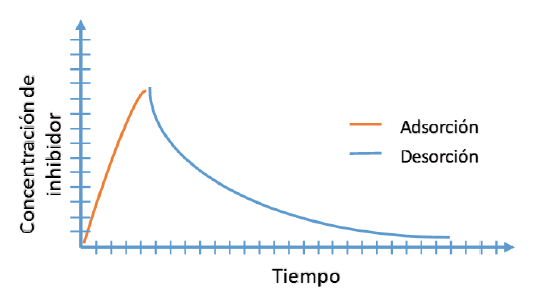Adjustment of a mathematical model of adsortion/desortion of an inorganic scales inhibitor

Published 2019-06-30
Keywords
- Coreflooding,
- Inhibitor,
- Squeeze,
- Mathematical model,
- Adsorption
- Desorption ...More
How to Cite
Abstract
During the oil production phase, mineral compounds or crystals can precipitate in both the pores of the vicinity of the well and the pipes due to thermodynamic changes that occur by the extraction of hydrocarbons over time. Such a phenomenon is known as inorganic scales.
This problem costs billions of dollars a year to the industry. Therefore, in the fields where this problem is present, the use of inhibiting agents that mitigate the formation and subsequent deposition of the scale is required. When carrying out a scale inhibition treatment, it is expected that the injected inhibitor be able to prevent the formation of such scales while remaining attached to the porous surfaces. Such treatments must be repeated periodically, which increases the lifting cost in those fields.
The purpose of this work is to adjust the mathematical description of the adsorption/desorption phenomenon in order to improve both the treatment designs and the simulation times. Our work finishes mentioning that factors such as formation water pH, compatibility of injected fluids with reservoir fluid and the minimum inhibitor concentration are the elements to take into account with the reservoir properties as Temperature and Pressure are key points in the adjustment because they are the influential factors in the time in which the inhibitor will remain in the reservoir avoiding the presence of the scale.
Downloads
References
Khormali, A., Petrakov, D. G., & Moghaddam, R. N. (2017). Study of adsorption/desorption properties of a new scale inhibitor package to prevent calcium carbonate formation during water injection in oil reservoirs. In Journal of Petroleum Science and Engineering. https://doi.org/10.1016/j.petrol.2017.04.008
Li, J., Tang, M., Ye, Z., Cheng, L., & Zhou, Y. (2016). Scale formation and control in oil and gas fields: A review. Journal of Dispersion Science and Technology,). https://doi.org/10.1080/01932691.2016.1185953.
Martínez, R. (2017). Modelo Fenomenológico de remoción del daño a la formación asociado a la depositación de escamas inorgánicas del tipo carbonato y sulfato. Universidad Industrial de Santander.
Meyers, K. O., Skillman, H. L., & Herring, G. D. (1985). Control of Formation Damage at Prudhoe Bay, Alaska, by Inhibitor Squeeze Treatment. Journal of Petroleum Technology, 1019–1034.
Navarro, S. F. M., & Meneses, Y. M. S. (2008). Generalidades de la formación, prevención y tratamiento de depósitos de escamas. Revista Fuentes, 6(1).
Pastor Lomo, G. (Sin fecha). Aseguramiento de Flujo de crudos de Petróleo: Estudio de compatibilidad de Aguas. Universidad Rey Juan Carlos.
Sánchez, J., Lopera, S., Cortés, F., & Ocampo, A. (2017). Adsorción Dinámica de Surfactantes Enfocados a Procesos de Recobro Mejorado. Tesis de Maestría, Universidad Nacional de Colombia, Bogotá, Colombia.
Smith, P., Clement, C., & Rojas, A. M. (2000). Combined Scale Removal and Scale Inhibition Treatments. International Symposium on Oilfield Scale. https://doi.org/10.2118/60222-ms
Shuler, P. J. (1993). SPE 25162 Mathematical Model for the Scale-Inhibitor Squeeze Process Based on the Langmuir Adsorption Isotherm. SPE International Symposium on Oilfield Chemistry, 107–120.
Sorbie, K. S., & Yuan, M. D. (1991). The Modelling and Design of Scale Inhibitor Squeeze Treatments in Complex Reservoirs. In SPE International Symposium on Oilfield Chemistry.
Sorbie, K. S., & Laing, N. (2004). How Scale Inhibitors Work: Mechanisms of Selected Barium Sulphate Scale inhibitors Across a Wide Temperature Range. SPE International Symposium on Oilfield Chemistry, 1–10. https://doi.org/10.2118/87470-ms
Sorbie, K., & Gdanski, R. (2005). A Complete Theory of Scale-Inhibitor Transport and Adsorption/Desorption in Squeeze Treatments. In SPE International Symposium on Oilfield Scale held in Aberdeen, United Kingdom, 11-12 May. https://doi.org/10.2523/95088-MS
Toro, G. M., Herrera, J. J., Orrego, J. A., Rojas, F. A., Rueda, M. F., & Manrique, E. J. (2018). Effect of ionic composition in water: oil interactions in adjusted brine chemistry waterflooding: preliminary results. Fuentes: El reventón energético, 16(2), 73-82.
Vanegas, C. L., Buendía, H., & Carrillo, L. F. (2016). Evaluación y selección de un inhibidor multiscale para prevenir la formación de incrustaciones inorgánicas en un campo petrolero colombiano. Revista Fuentes, 14(2), 111-120.
Villar, A., Moreno, Carrillo, L. F., Hernandez, J. H. C., & Molina, J. J. R. (2017). Predicción del daño a la formación por acumulación de CaCO3 durante el flujo constante de salmueras en el medio poroso. Fuentes: El reventón energético, 15(1), 49-57.
Zavala, J. A. P., Mackay, E. J., Vazquez, O., Boak, L. S., Singleton, M., Ross, G., & Uk, S. (2008). The Cost and Value of Field, Laboratory, and Simulation Data for Validating Scale Inhibitor Treatment Models.
Zhang, H., Mackay, E. J., Chen, P., & Sorbie, K. S. (2000). Non-Equilibrium Adsorption and Precipitation of Scale Inhibitors: Corefloods and Mathematical Modelling. Edinburgh, Scotland.